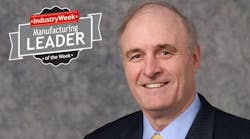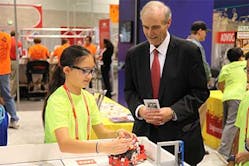At the recent Automation Fair 2014 IndustryWeek had the opportunity to talk with Rockwell Automation (IW 1000/633) CEO Keith Nosbusch about how the connected enterprise will enable manufacturers to be more competitive.
Q: You believe that we are just beginning the journey of the connected enterprise which is being driven by the convergence of IT with OT (operations technology). What benefits should the industrial sector expect from this new business model?
A: The new model is not just about automation. While automation has helped with the quality speed, and sophistication of both the equipment and the information it provides, the critical issue is taking productivity to next level. How can we provide the right information at the right time to make faster better business decisions?
Integration will be the next wave. Companies are starting to do that now by putting in the network infrastructure. But at the end of the day it’s about competitiveness. How are U.S. manufacturers going to remain globally competitive? A company needs to differentiate itself in the market.
Q: While manufacturers have begun the journey of gathering data from machines, a recent study by IW shows that only 14% have the equipment necessary to take advantage of the IoT (Internet of Things) model. What will drive them to invest in this technology?
A: Their willingness to invest will be a matter of them being able to see a benefit from their investment. We see four specific areas that are the drivers behind the connected enterprise which will cause companies to invest. The drivers are: faster time to market, lower total cost of ownership, Improved asset utilization, enterprise risk management.
I would point to one immediate benefit which is to optimize machine OEE which will provide an immediate return. As I attend a number of CEO summits around the country I do see more investments in OEE strategies.
The good news is that companies do have cash. However they are skeptical of taking things at face value. They want to see an ROI before they invest; that’s why there is some hesitancy today.
What I am seeing in manufacturing is a tipping point. There has been a change. Manufacturing has again become a topic of conversation. It is now viewed as very relevant in the U.S. While there are a lot of reasons for this, the main point is that you can’t have a robust economy or thriving middle class without this sector. It creates a great deal of wealth.
The U.S is very competitive in this sector. We have done a good job and are ready to take things to the next level.
Q: One area that is causing concern for manufacturers is whether they will have the talent they need to take things to the next level.
A: The skills gap is huge and has been recognized.
One way to view a solution is that perhaps everyone doesn’t have to go to college but everyone needs to have skills. We need to have a positive attitude with regard to manufacturing as a career so that kids want to go from high school into manufacturing jobs. We need to return to the tradition of trade education that were roadmaps for careers.
We are seeing a partnerships between businesses and high schools, community and technical colleges encouraging students to enroll in STEM programs.
And many organizations such as national associations, unions and other groups are speaking out for the need for skilled talent.
From a broader perspective the workforce must be engaged in lifelong learning. Things will continue to change and employees will always have to reinvent themselves to remain relevant to whatever needs arise.
Q: Continuing with the broader perspective, how will the connected enterprise, in conjunction with the IoT improve our economic situation.
A: Automation increases productivity at end of the day. And that will raise the standard of living. Even as we have less direct labor with this new model, high tech jobs and processes do have a multiplier effect.
The multiplier effect of automation is the ability to take the data from the connected machines, or enterprise, and figure out how to utilize the data to make faster and better decisions. These decision-making improvements will drive global competitiveness. In fact it’s the next frontier of competitiveness.




